Art and Technology
Christina Martidou, Greece
English Language and Literature from the Aristotle University of Thessaloniki and an MA in Media, Culture and Communication from the Institute of Education. She has been working both freelance and in private schools preparing students for all the Cambridge ESOL exams for the past twelve years. She has a genuine interest in the use of technology, Web 2.0 tools and social media in foreign language teaching. Christina blogs at http://christinamartidou.edublogs.org where she shares her insights about educational technology as well as her own technology-based materials.
E-mail: martidouchristina@gmail.com , Twitter: @CMartidougr

Menu
Introduction
Topic 1: ‘Love is all you need’
Topic: 2 ‘Mystery Death at the Dark Mansion’
These lesson outlines aim to implement art and technology effectively in the English language classroom. Art is everywhere, providing an inexhaustible yet underused cultural and educational resource. My wish is to exploit its massive educational value and give it a ‘fresh’ feel with the use of technology so as to motivate English language learners, extend their learning and empower their creativity. In this direction, I have used famous works of art made by Botero, Magritte, and Picasso etc. with an educational interest which act as the springboard for our lessons.
What makes these lesson plans stand out is the fact that the recommended language activities include the use of technology and easily accessible, impressive Web 2.0 tools such as LittleBirdTales, Wordle and Taxgedo (see Going ‘techy’ section). This way, I want to make learning more fun, creative, meaningful as well as relevant to students’ out-of-school reality.
Level: Elementary +
Time: Two 40’ sessions
Aim: To help students become familiar with different types of families, share personal stories and become more articulate.
What you need: a computer, an Internet connection, a printer, PowerPoint.
Session 1
Procedure:
A. Oral work: You ask students the following warm-up questions:
- How many people are there in your family?
- Do you get on well with your siblings? - How have they influenced your life?
- What is the fondest memory you have of your family doing something together?
- What’s the best piece of advice your parents have given you?
- How important is family to you?
B. Students look at the four family portraits given below and discuss about their similarities and differences (number of people, setting, appearance, facial expressions, feelings, relationships).
‘A family/ Una familia’ ‘The Widow’ by Fernando Botero
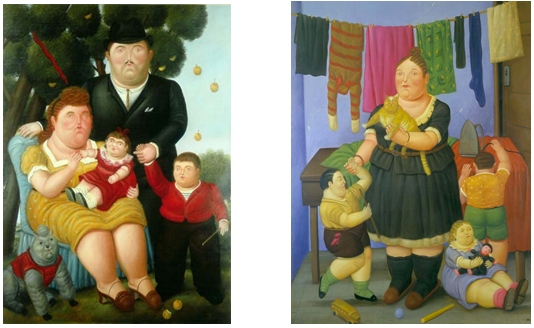
‘The Soler Family’ by Pablo Picasso
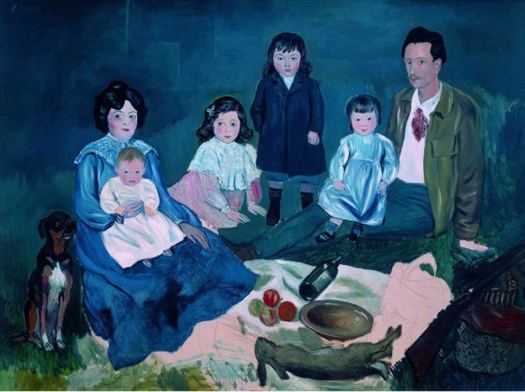
‘The Happy Family’ by Ferdinand Georg Waldmuller
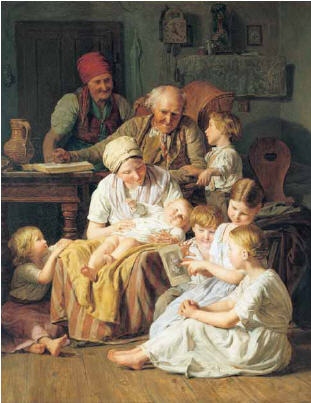
- What other kinds of families can you think of?
Possible Answers: Nuclear families (parents+ children), single parent family (mother- only or father-only), grandparent- led families, stepfamilies, and gay/lesbian- families (parents of the same sex).
- Ask them to brainstorm famous families they know from TV series, films, magazines and books, e.g. The Simpsons, The Flintstones, Harry Potter’s family, Adam’s family, The British Royal family, The Beckhams...
C. The teacher writes the following phrases on the board:
My dad/ mum works as a...
Our favourite family activity is...
Our best/worst family holiday was...
The best/ worst thing about my mum/dad/brother/sister is...
Students are divided into groups of two or three. Using the given set phrases, each student writes four statements about his/her family on a piece of paper. However, one of them is false. Students share their sentences within their groups while the rest try to figure out which one is the lie.
Next, students say one new thing they have learnt about one of their partners in front of the whole classroom.
This activity is ideal for new classes as it encourages their bonding.
Follow-up
Written Homework:
Students choose a favourite family photo and write a paragraph (up to 80 words) giving details about who, where, when, what and why this is one of their favourite pictures.
Variation
Students can create a PowerPoint presentation of their families, using up to five photos each and make a short presentation in the next class talking about their families to their fellow students.
Session 2: Going ‘techy’
A. Take students to the computer lab. Divide them into pairs of 2 or 3. Write the website www.wordle.net on the board or open the browser for each computer for children before they come in. Ask students what in their opinion are some of the most important key traits of a happy family. In pairs, they create their word clouds using Wordle. Students can play with the fonts and different colour schemes available.
Here is an example of what students’ wordles will look like:
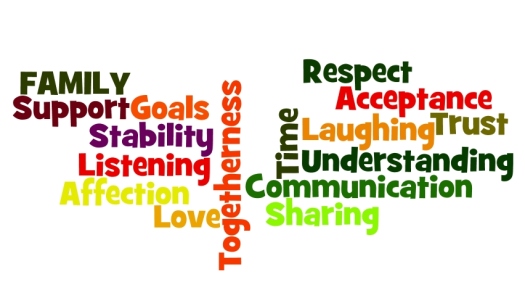
B. You can print students’ word clouds out and display them on the classroom’s bulletin board.
Variation
Alternatively, ask students to save a screenshot of their word clouds using the ‘print screen’ button on the keyboard. Then they should paste them on a word document and email them to you.
Collect the wordles, create a PowerPoint slideshow and show it in the next class. Which is the most common word? What makes a family happy?
Follow up
Written homework:
Students write a paragraph (80 words) about their favourite family activity.
** Wordle is a free, fun word cloud generator. You don’t have to sign up. You just copy& paste your text to create and customize your word cloud. Alternatively, you can use a similar online tool called Taxgedo (www.tagxedo.com) which is also free, easy-to-use and gives you the opportunity to constrain word clouds to selected beautiful shapes/silhouettes such as hearts, stars, animals, famous portraits and so on.
Level: Intermediate and above
Time: Three 45’ sessions
Aim: Becoming familiar with the secrets of good storytelling and the use of past tenses.
‘The Empire of Lights’ by Rene Magritte
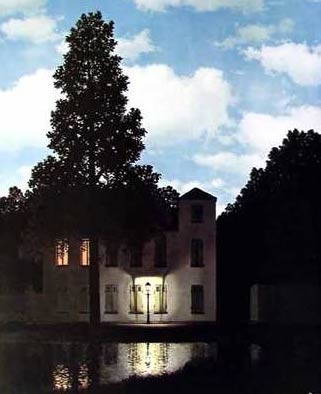
Session 1
Procedure
A. Students look at Magritte’s painting ‘The Empire of Lights’- ‘L'Empire des lumières’ and answer the following questions.
- How would they describe it? Possible answers: mysterious, serene, contradictory, gloomy, harmonious...
- Is there anything unnatural about it? How does light function? -Discuss the sharp light contrasts (i.e. a lit-up house, darkness of the night, the surreal bright daytime sky over the house and tree line).
- How does the painting make them feel? - What thoughts does it evoke?
B. Ask students to brainstorm some of their favourite mystery novels or/and films, e.g. novels: Murder on the Orient Express, Crooked House, The Curious Incident of the Dog in the Night-time, Rebecca, The Phantom of the Opera or movies: Sherlock Holmes, Sleuth, The Sixth Sense, Citizen Cane, Chinatown.
The class is divided into groups of 3. The teacher writes the word ‘MYSTERY’ on the board. Students note down the first 10 relevant words that come to mind. Then, the groups compare their lists and come up with the three most common words. (e.g. murder, blood, sleuth).
- What are the main characteristics of murder mystery stories? (e.g. suspense, secrets, unexpected twist of events...).
C. Choose a short mystery story or part of it and use it as a model to teach students the elements of good storytelling in terms of organization, structure and content. (paragraph division, use of time expressions and connectors, clear order of events, use of past tenses& direct speech to quote words or thoughts, interesting characters, engaging plot, rising action, climax, resolution...).
Follow up (Written homework)
Students can work in pairs. Hand out the following topic and ask them to make up their own story so as to unlock the mysterious death of a well- respected judge.
Help solve an open murder case

The owner of this mansion, the distinguished Judge Wilson, was found dead by his housekeeper two days ago. He was lying at the foot of the stairs leading to the wine cellar. You are a master private investigator and have to resolve this mysterious death. The only 5 clues you have at your disposal are a smoking pipe, a half- eaten green apple, a stained red tie, blood pressure pills and the following note found in the victim’s trousers pocket.
Write your story based on the police’s findings. What happened to Judge Wilson? Your answer should be 120- 180 words.
Session 2: Going ‘techy’
Level: Intermediate and above
What you need: Computer Lab, Internet connection.
Aim: Creating an online storybook

Procedure
Return the stories corrected. Take children to the computer lab. Write the following website on the board http://littlebirdtales.com or open the browser for each computer for children before they come in. Littlebirdtales is a free online tool. You need to sign up in order to use it. You can either create an individual or school account according to your needs by providing an email address.
Ask students to create their own online mystery tale following 3 easy steps. They can upload digital pictures, images, artwork, import text (their stories in this case) and record their own voices to make their stories ‘come alive’. As soon as students finish their online stories, they email them to you. In the next (3rd) session, students watch and comment on their mystery tales and the different ways each group shed light on Judge Wilson’s death. They vote for the best mystery story!

Please check the Creative Methodology for the Classroom course at Pilgrims website.
Please check the ICT - Using Technology in the Classroom – Level 1 course at Pilgrims website.
Please check the Methodology and Language for Primary Teachers course at Pilgrims website.
Please check the Methodology and Language for Secondary Teachers course at Pilgrims website.


|